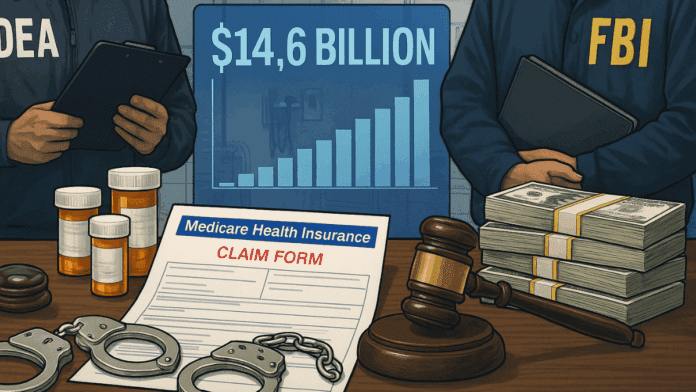In a nationwide operation, the U.S. government has charged 324 people for their alleged roles in a massive health care fraud scheme worth more than $14.6 billion. This is the largest action of its kind in American history and includes charges against doctors, nurses, pharmacists, and other licensed professionals. Authorities accused these individuals of cheating government health programs like Medicare and Medicaid by filing false claims or providing unnecessary or fake treatments.
The takedown spanned across 50 federal districts and involved enforcement from both federal and state agencies. Officials say that the defendants worked together in different types of schemes, including those involving fake medical equipment, false opioid prescriptions, and unneeded lab tests. Some also targeted the elderly, people on hospice care, and even homeless individuals.
To put the size of the case into perspective, this takedown more than doubles the previous record of $6 billion in health care fraud. Government agencies seized over $245 million in cash, luxury cars, cryptocurrencies, and other high-value items connected to the crimes. They also blocked more than $4 billion in attempted fraudulent payments before the money could be sent out.
Fraud Rings, Stolen Identities, and Global Reach
Some of the fraud schemes were highly organized and included people working across different countries. In one of the biggest cases, a group created a web of companies across the U.S. that submitted over $10 billion in fake claims to Medicare. These companies billed for medical devices like catheters using the stolen names and health information of over one million Americans. The group used fake owners and secret communication apps and moved money through cryptocurrency and foreign bank accounts to avoid detection.
DMERx CEO Gary Cox Convicted in $1 Billion Medicare Fraud Scheme
Thanks to advanced data tracking systems, law enforcement was able to stop most of the payments from going through. However, around $900 million still ended up in the hands of the criminals. Officials have already recovered about $27.7 million of that amount and expect to return even more assets.
Another case involved fake audio recordings created by artificial intelligence. Scammers recorded fake patient voices to make it sound like they were agreeing to medical services they never requested. They sold this false information to companies, which then billed Medicare for services that were never provided. This scheme alone led to around $703 million in fake claims, with nearly $418 million actually paid out before authorities stopped it.
In Arizona, a different group targeted Native American communities and homeless populations. They billed Medicaid for addiction treatment services they either never delivered or provided at such a poor quality that the care was considered worthless. One member of the scheme even bought a $2.9 million luxury home overseas with the stolen money.
Dangerous Drugs, Fake Clinics, and Telehealth Scams
The crackdown also targeted those illegally distributing prescription drugs like opioids. Authorities charged 74 people with distributing over 15 million pills. One Texas pharmacy dispensed more than 3 million opioid pills, which were later sold on the streets. Law enforcement says these crimes have worsened the country’s drug addiction crisis and led to serious health risks.
Another major area of fraud involved telemedicine and genetic testing. Scammers used phone calls and online platforms to trick elderly patients into giving personal health details. Then, companies submitted bills to Medicare for costly lab tests and medical equipment that were never actually used. In total, these scams led to more than $1.17 billion in false claims.
Some health care providers also stole medicine intended for their own patients, including children. In other schemes, medical companies billed for services that were never provided or gave kickbacks to doctors in return for patient referrals—something that is illegal.
To fight back, government agencies have started sharing information and using data tools powered by artificial intelligence. This approach helped them detect suspicious patterns quickly and launch targeted investigations.
The operation involved dozens of law enforcement groups, including the FBI, Drug Enforcement Administration, Department of Health and Human Services, and several state attorneys general. These teams worked together to uncover and charge hundreds of individuals in this sweeping fraud operation.


